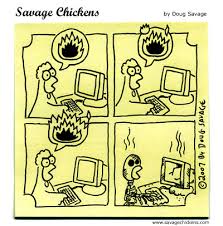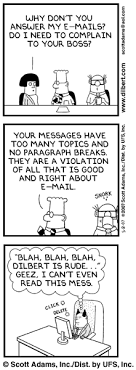Have you ever received an email that you misunderstood? Unlike face-to-face conversation, email is very easy to misinterpret as there are no facial expressions or vocal cues to aid understanding. That is why it is important that any emails you send to customers in your role as Customer Support Specialist (CSS) are well-written and concise. You can make your messages easier to read and understand by following a system of rules often referred to as email etiquette. In the support center, it is important that you are as comfortable communicating with customers using email as you are using the telephone.
You can make your messages easier to read and understand by following a system of rules often referred to as email etiquette. In the support center, it is important that you are as comfortable communicating with customers using email as you are using the telephone.
When sending professional emails, you should:
* Use proper case: Correct usage of capitalization will make your message easier to read. In email culture, words written in uppercase are considered "SHOUTING."
* Review and check for spelling errors: Email language is usually more casual than that used in a formal letter, so it's easy to approach email communication in a somewhat sloppy manner. However, a misspelled word or the incorrect placement of a comma can change the meaning of a sentence. Most email software includes a spelling tool that checks documents for errors. You should always use this spelling tool to check your messages before sending.
* Ask the recipient's permission to send attachments: Attachments can create difficulties for email recipients. They can be incompatible with the recipient's software, as well as time-consuming to download. Also, some workplace systems place limits on the size of files that can be received.
* Send only worthwhile messages: Because email is so easy to use, users generate a large amount of unwanted email. Junk email, or spam, is annoying and time-consuming to deal with, and can also slow your server down. Most business people today are extremely busy and time-conscious. They generally do not wish to receive junk email or mail that is unrelated to their work.
* Include original messages when sending replies: Unless they are reminded of what the previous message was about, recipients can lose track of email discussions, particularly long ones.
* Make the subject line specific and eye-catching: If the subject line is specific, the recipients will have a better idea of how to prioritize your email among the many others that they receive. For example, the subject line on a reply to a customer query about software installation steps might read "Installing Software." By following the rules for email etiquette, your messages will be more easily understood, you will save time, and the recipient will be more aware of your motivation and intentions.
By following the rules for email etiquette, your messages will be more easily understood, you will save time, and the recipient will be more aware of your motivation and intentions.
It is important to practice the rules of email etiquette. The use of proper case, along with the practice of reviewing and checking for spelling, will make your email messages easier to read.
Remember to check with your recipient before sending attachments over email. Send only worthwhile attachments, include the original message with your reply, and remember to include a specific subject line. These are all valuable practices that will make your email easy to understand.
Vital Email Etiquette To Follow
Posted by simple | Thursday, February 12, 2009 | Communication_Tips, Customer_Service, Office Tips, Office_Profession | 0 comments »Translate: Português | Français | Español | Deutsch | Italiano | 中文 | 한국어 | 日本語 | العربية
Subscribe to:
Post Comments (Atom)














0 comments
Post a Comment